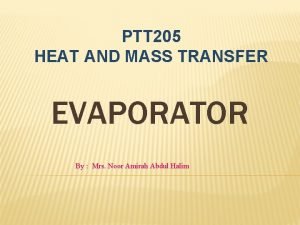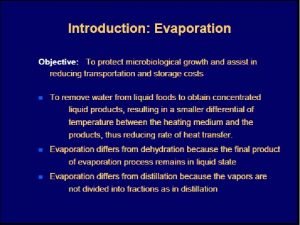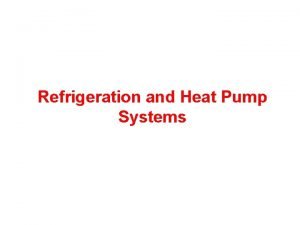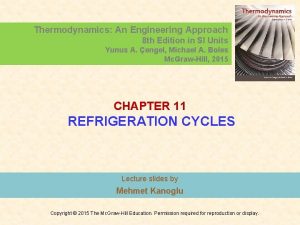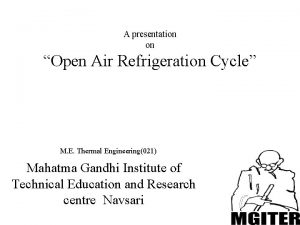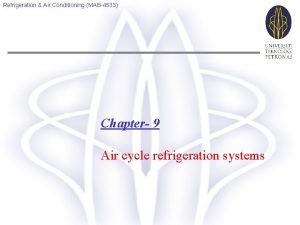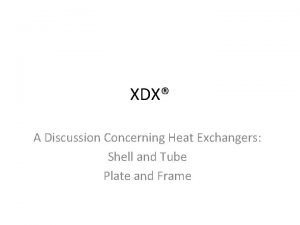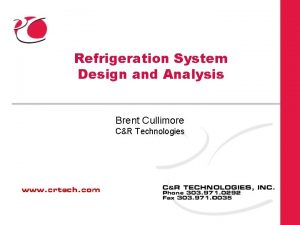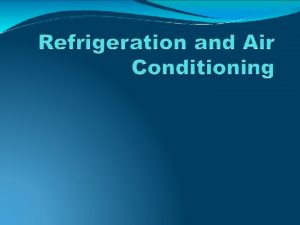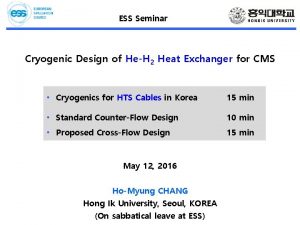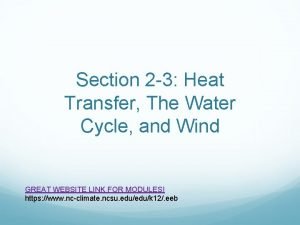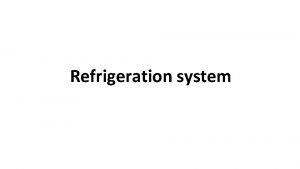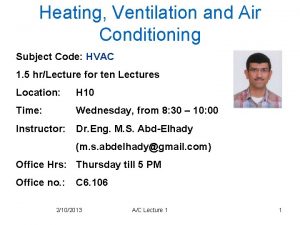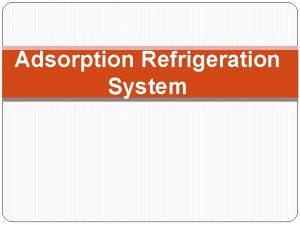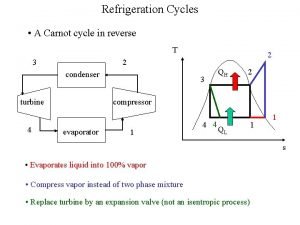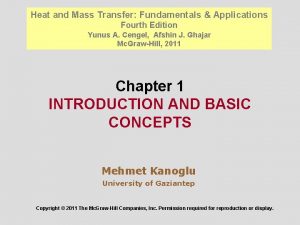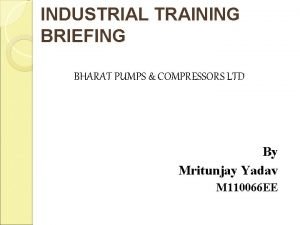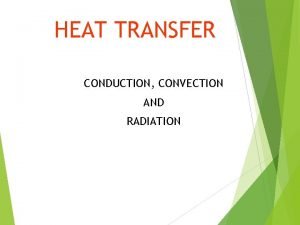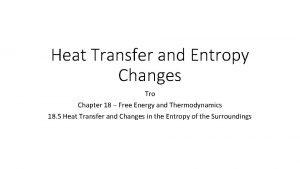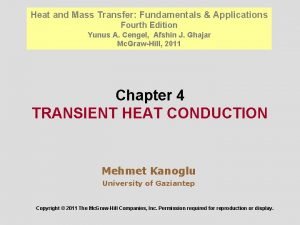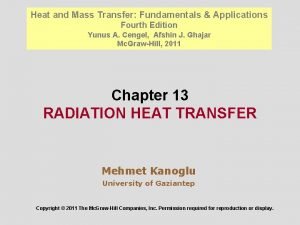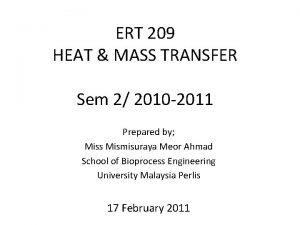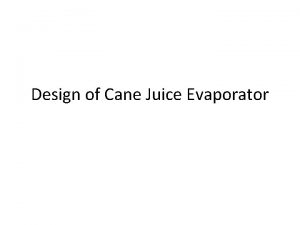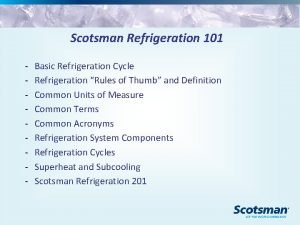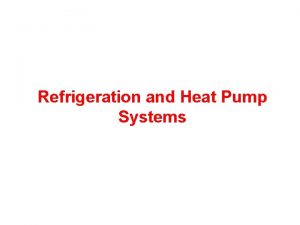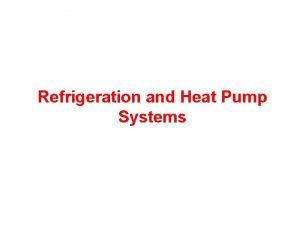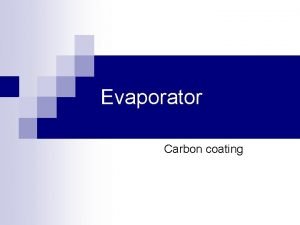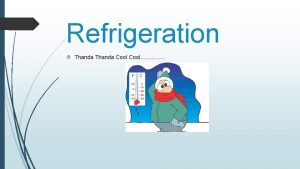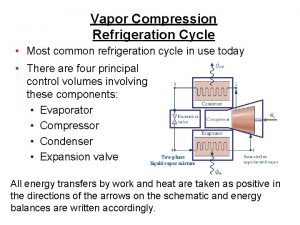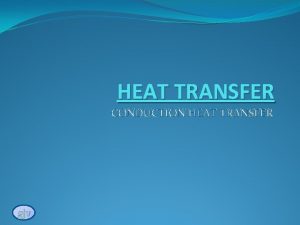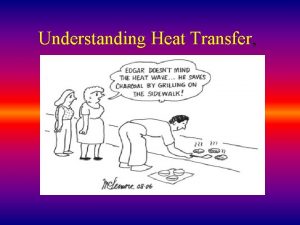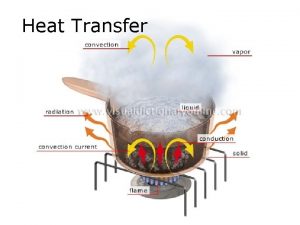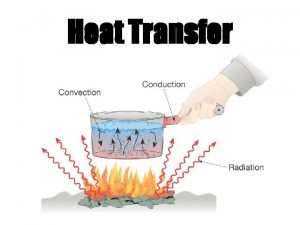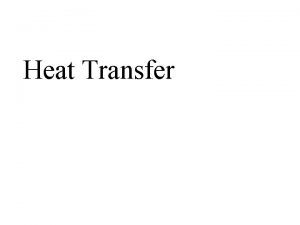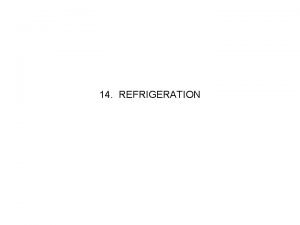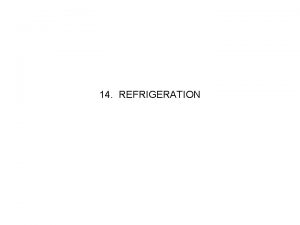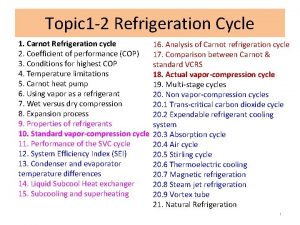1 Heat Transfer and Refrigeration Cycle Evaporator Compressor
























- Slides: 24

1. Heat Transfer and Refrigeration Cycle Evaporator Compressor Fan Condenser Automotive – Heating & Air Conditioning Heat Transfer and Refrigeration Cycle Topics covered in this presentation: n Heat Transfer Principles n Refrigeration Cycle Basics Class. Act SRS enabled.

1. Heat Transfer and Refrigeration Cycle Automotive – Heating & Air Conditioning Principles of Heat Transfer Principle 1 Heat always flows from hot to cold objects. Rate of heat transfer increases as difference in temperature between two objects increases. Principle 2 Cold objects have less heat than hot objects of the same mass. To make an object colder remove heat. To make an object hotter add heat. Next >

1. Heat Transfer and Refrigeration Cycle Automotive – Heating & Air Conditioning Question 1 Is it correct to say that when we open the door of a heated room we let the cold in? Answer Yes or No.

1. Heat Transfer and Refrigeration Cycle Automotive – Heating & Air Conditioning Principles of Heat Transfer Principle 3 When liquid changes to vapour, a large amount of heat is absorbed. When vapour changes to a liquid, a large amount of heat is released. 2100 joules is quantity of heat required to raise temperature of 1 kg of water by 1°C. Principle 4 When vapour cooled below dew point it becomes a liquid - condensation. One kilogram of 100°C vapour has to release 2. 26 x 106 joules of heat to change to water at 100°C. Next >

1. Heat Transfer and Refrigeration Cycle Automotive – Heating & Air Conditioning Question 2 How many joules of energy are required to heat 5 kg of water by 10 degrees centigrade? A) 10500 B) 21000 C) 105000 D) 1050000

1. Heat Transfer and Refrigeration Cycle Automotive – Heating & Air Conditioning Principles of Heat Transfer Principle 5 Increasing the pressure on a liquid or vapour increases its boiling point. Decreasing the pressure on a liquid or vapour decreases its boiling point. Principle 6 When vapour is compressed both its temperature and pressure increase, without additional applied heat. Example: The radiator cap on a vehicle allows the water in the cooling system to reach a pressure of 1. 1 bar. Therefore the boiling point occurs at 125°C. Next >

1. Heat Transfer and Refrigeration Cycle Automotive – Heating & Air Conditioning Question 3 A gas has to lose heat in order to change from a gas to a liquid. Is this true or false? Answer True or False.

1. Heat Transfer and Refrigeration Cycle Automotive – Heating & Air Conditioning Principles Applied to Air Conditioning A good basic example of how an air conditioning (A/C) system works is discharging an aerosol can. Pressurized liquid is held within the can (high pressure side of the system). The top or nozzle (restriction) is depressed. The contents are released into the atmosphere (low pressure side). In the case of a cosmetic (deodorant) aerosol, the contents feel cold when applied to the skin. If the aerosol was sprayed into the inside of a heat exchanger (evaporator) and air was blown across the heat exchanger, the air would be cooled. Next >

1. Heat Transfer and Refrigeration Cycle Automotive – Heating & Air Conditioning Basic Air Conditioning System Compressor Evaporator Air movement fans Condenser Tube and fin heat exchangers Fixed Orifice Tube or Thermal Expansion Valve (placed in line near the evaporator to create a restriction causing a pressure drop) Tubing Next >

1. Heat Transfer and Refrigeration Cycle Automotive – Heating & Air Conditioning Question 4 What material would the evaporator and condenser coils of an air conditioning system be made from? A) rubber tube B) metal tube C) nylon tube D) glass tube

1. Heat Transfer and Refrigeration Cycle Automotive – Heating & Air Conditioning The Compressor The compressor pulls in low pressure vapour. It pumps out high pressure vapour. This pressurization raises the temperature of the vapour. Compressor Condenser Next >

1. Heat Transfer and Refrigeration Cycle Automotive – Heating & Air Conditioning The Condenser The compressor pumps high pressure vapour into condenser. The high pressure vapour is cooled by the ram air flow. Compressor Condenser The vapour condenses into a liquid. Heat loss changes the vapour into a high pressure liquid. Next >

1. Heat Transfer and Refrigeration Cycle Automotive – Heating & Air Conditioning Expansion Valves Expansion valves restrict refrigerant flow. Evaporator Compressor Condenser Two main types: n Thermal Expansion Valve (TXV). n Fixed Orifice Tube (FOT). The compressor pumps against the restriction, so the pressure rises in the condenser. The compressor sucks against the restriction, so pressure lowers in the evaporator. Fixed Orifice Tube (FOT) Thermal Expansion Valve (TXV) Next >

1. Heat Transfer and Refrigeration Cycle Automotive – Heating & Air Conditioning The Evaporator The evaporator removes heat and humidity from the vehicle’s interior. Evaporator Condenser Low pressure liquid refrigerant flows from the expansion valve into the evaporator. Compressor The liquid absorbs heat, and changes into a low pressure vapour. The compressor pulls low pressure vapour from the evaporator. Expansion valve Next >

1. Heat Transfer and Refrigeration Cycle Automotive – Heating & Air Conditioning Question 5 Which part, in an air conditioning system, turns the low pressure vapour into high pressure vapour? A) Compressor B) Condenser C) Evaporator D) Fan

1. Heat Transfer and Refrigeration Cycle Automotive – Heating & Air Conditioning Question 6 Where in an air conditioning system does the high pressure vapour turn to high pressure liquid? A) Compressor B) Condenser C) Fixed orifice tube D) Evaporator

1. Heat Transfer and Refrigeration Cycle Automotive – Heating & Air Conditioning Question 7 Where in an air conditioning system does high pressure liquid turn to low pressure liquid? A) Compressor B) Condenser C) Fixed orifice tube D) Evaporator

1. Heat Transfer and Refrigeration Cycle Automotive – Heating & Air Conditioning Question 8 Where in an air conditioning system does the liquid absorb heat? A) Compressor B) Condenser C) Fixed orifice tube D) Evaporator

1. Heat Transfer and Refrigeration Cycle Automotive – Heating & Air Conditioning Question 9 In which part of an air conditioning system does heat leave the system? A) Compressor B) Condenser C) Fan D) Evaporator

1. Heat Transfer and Refrigeration Cycle Automotive – Heating & Air Conditioning Basic Air Conditioning System Operation - 1 The compressor creates a high pressure side and a low pressure side. Typical high side pressure = 12 bar. Typical low side pressure = 2 bar. The pressure drop causes the temperature and the boiling point of the refrigerant to drop. LOW 2 BAR HIGH 12 BAR VAPOUR 0ºC VAPOUR 40ºC Evaporates liquid to vapour LIQUID / VAPOUR Fine mist 0ºC Condenses vapour to liquid LIQUID 40ºC Restriction causes pressure drop Next >

1. Heat Transfer and Refrigeration Cycle Automotive – Heating & Air Conditioning Question 10 What is the purpose of the fixed orifice tube? A) To raise the temperature B) To increase the speed of flow C) To reduce the pressure D) To change the vapour into a liquid

1. Heat Transfer and Refrigeration Cycle Automotive – Heating & Air Conditioning Basic Air Conditioning System Operation - 2 If 38°C air surrounds evaporator, the refrigerant will absorb heat. The liquid changes to vapour, and the surrounding air is cooled. The vapour is pumped into the condenser, so raising both its temperature and its pressure. LOW 2 BAR HIGH 12 BAR VAPOUR 0ºC VAPOUR 40ºC Evaporates liquid to vapour LIQUID / VAPOUR Fine mist 0ºC Condenses vapour to liquid LIQUID 40ºC Next >

1. Heat Transfer and Refrigeration Cycle Automotive – Heating & Air Conditioning Basic Air Conditioning System Operation - 3 The vapour is now hotter than the surrounding 38°C air. Heat transfers to the surrounding air. The heat loss changes the vapour to a liquid. This is back to the start of the cycle, where it is repeated until the A/C is switched off. LOW 30 PSI HIGH 175 PSI VAPOR 32ºF VAPOR 103ºF Evaporates liquid to vapor LIQUID / VAPOR Fine mist 32ºF Condenses vapor to liquid LIQUID 103ºF Next >

1. Heat Transfer and Refrigeration Cycle Automotive – Heating & Air Conditioning Summary You should now be aware of: n Heat Transfer Principles n Refrigeration Cycle Basics End >
 Heat and mass transfer
Heat and mass transfer Single effect evaporator diagram
Single effect evaporator diagram Refrigeration cycle thermodynamics
Refrigeration cycle thermodynamics Multipurpose refrigeration systems with a single compressor
Multipurpose refrigeration systems with a single compressor What is open air refrigeration cycle
What is open air refrigeration cycle Cop in refrigeration
Cop in refrigeration Plate type exchanger
Plate type exchanger Refrigeration system design
Refrigeration system design Simple air cooling system
Simple air cooling system Standard refrigeration heat exchanger
Standard refrigeration heat exchanger Hydrological cycle
Hydrological cycle Refrigerant cycle
Refrigerant cycle Cop of heat pump and refrigerator
Cop of heat pump and refrigerator Adsorption system
Adsorption system Carnot cycle refrigerator
Carnot cycle refrigerator Matlab refrigeration cycle
Matlab refrigeration cycle Heat and mass transfer fundamentals and applications
Heat and mass transfer fundamentals and applications Storage type heat exchanger
Storage type heat exchanger Bpcl industrial training
Bpcl industrial training What is heat transfer conduction convection and radiation
What is heat transfer conduction convection and radiation Radiation example
Radiation example Entropy and heat transfer
Entropy and heat transfer Heat and mass transfer cengel 4th edition pdf
Heat and mass transfer cengel 4th edition pdf Fundamental of heat and mass transfer
Fundamental of heat and mass transfer Bulk temperature formula
Bulk temperature formula
